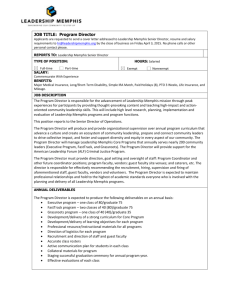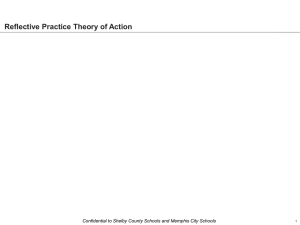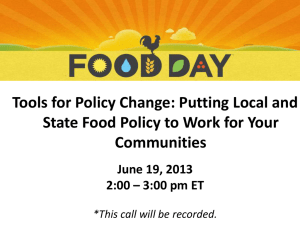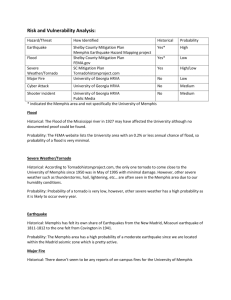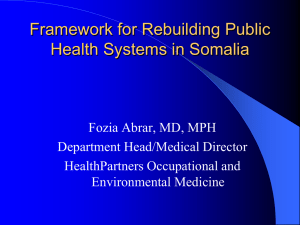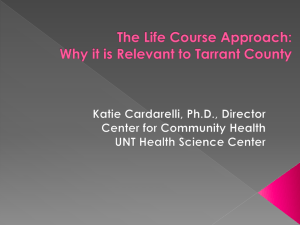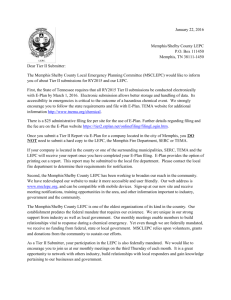PPT - National Neighborhood Indicators Partnership
advertisement
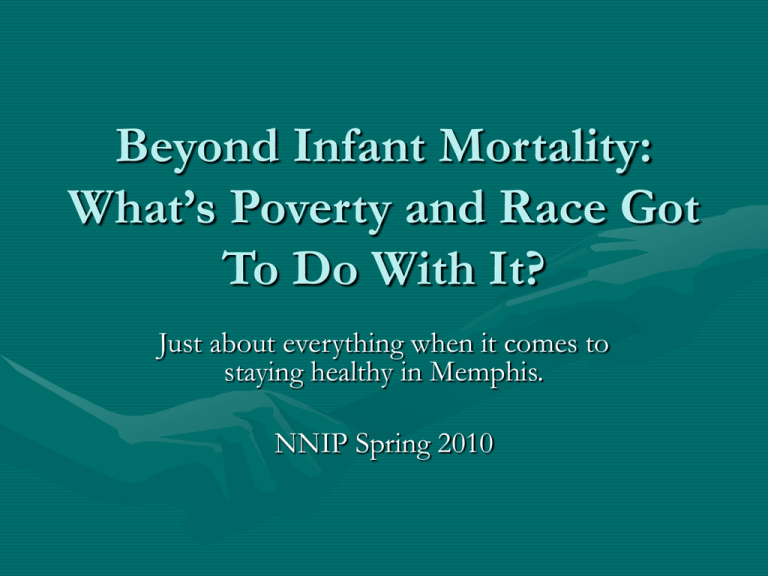
Beyond Infant Mortality: What’s Poverty and Race Got To Do With It? Just about everything when it comes to staying healthy in Memphis. NNIP Spring 2010 Phyllis G. Betts, Director Contact pbetts@memphis.edu Center for Community Building and Neighborhood Action and InfoWorks Memphis School of Urban Affairs and Public Policy The University of Memphis Key Sources • Populations of Color in Tennessee: Health Status Report. Tennessee Department of Health Office of Policy, Planning, and Assessment and Office of Minority Health. Kenneth Robinson, et. al. 2007. • Center for Community Building and Neighborhood Action: analysis of birth and infant mortality and other indicators for Memphis and Shelby County. Ongoing. Infant Mortality Initiative • • • • • Commercial Appeal feature followed by Babyland Shelby County Summit TN Office for Children’s Coordinated Care Infant Morality “Core Group” Established Shelby County Office for Early Childhood and Youth • Early Success Coalition • Voices for Memphis’ Children Infant Mortality: Canary in the Coal Mine • • • • 14 per 1000 2006 baseline African American twice as high as white births Drivers: Pre-maturity and low birth weight 30% African American teens give birth by age 17 (city of Memphis) • NICU progress at The Med • Individual education and social support: Blues Project, Moses Model, Centering Pregnancy • Social Marketing w/ Community Voice • FIMR: Community Action Team 2006 % Births w/ Infant Death of All Births, Shelby County 2.50% Percent of All Births 2.00% 1.50% All Mothers African American Mothers 1.00% 0.50% 0.00% 1999 2000 2001 2002 2003 Year 2004 2005 2006 Deaths Per 1000 Live Births, Top Ten Leading Causes of Death Shelby County, TN, 2006 Source: Death Certificate Data (Tennessee Resident Data),Tennessee Department of Health http://hit.state.tn.us/, accessed 5/11/2010 Early Success Coalition • Nurse Family Partnership and support for building infrastructure (HHS) • LeBonheur (Methodist) Children’s Hospital and Shelby County Office for Early Childhood and Youth • 65 provider partners • Linked with Site Based Services Collaborative • Data Partners: CBANA-InfoWorks and UTHSC Preventive Medicine/CANDLE • National Mathematica evaluation • Collaborative planning and grantwriting • Advocacy: Voices for Memphis’ Children Getting Organized Voices for Memphis’ Children Early Success Coalition Provider Partners Shelby County Early Childhood and Youth Early Success Focus Areas • • • • • • • Infant Mortality Initiative Home Visitation Parenting Support Headstart-PreK-Child Care Early Intervention JustCare Family Network and JustCare 180 Children’s Exposure to Violence →Community Risks and Assets: CBANA-InfoWorks →Policy Advocacy: Poverty as a Risk Factor Voices “Five Hopes” • Health • Behavioral Health • Education • Juvenile Justice • Social Equity: Unnatural Causes Poverty as a Risk Factor: Kids Heightened probability outcomes: • Infant mortality/prematurity/low birth weight and related diagnosis • Child obesity and diabetes • Lead poisoning/other heavy metal toxins • Asthma/other respiratory diagnosis (second hand smoke) • Nutrition-related developmental and cognitive diagnoses • Stimulation-related developmental shortfalls • Injuries from abuse, neglect, and neighborhood violence • Homicide Child Poverty in Shelby County Low Income 24% Dire Poverty 28% Below Poverty 15% Moderate and Higher Income 48% Reaching Families Where They Live Early Impact of Disparities Framework • Broaden focus to include Zone 2 • Asset Mapping • Transformation Institute: wrap-around system of care • Link with Site-Based Resident Services Collaborative: Reaching Families Where They Live • Toward a risk, assets, and segmentation model to drive action: Fragile Families framework The Bigger Picture: Social Determinants • Why are poverty and low educational attainment predictive of “unhealthy lifestyles”? • Hint: “ignorance” is an insufficient answer • • • • Aggravating factor: hardship Mediating factor: stress → depression Mitigating factor: social support Theory of change: stronger families in stronger communities – Confronting poverty Emerging Evidence: Stress • Cortisol, adrenalin, and inflammation • Biological markers vs. self-reports • Depression, self-medication, and immobilization vs. sense of efficacy and proactive self-care • Apparently self-destructive behavior is not just about poor self-esteem Primary Social Support Systems • Family • Neighborhood • Schools • Work • Housing as a Platform 1-Year Clinic Visit Data Outcome Measures Percentage Parental Stress Index Total Score (N = 114) 100 90 80 70 60 50 40 30 20 10 0 79.8 20.2 Clinically Significant Not Clinically Significant 1-Year Clinic Visit Data Outcome Measures Percentage Child Abuse Potential Score (N = 116) 100 90 80 70 60 50 40 30 20 10 0 83.6 16.4 Elevated Normal Reaching Families Where They Live: Peacemaking Circles at Autumn Ridge
